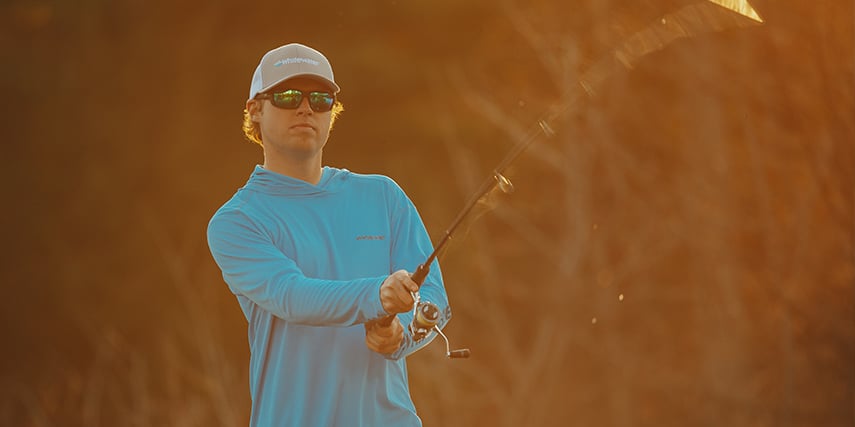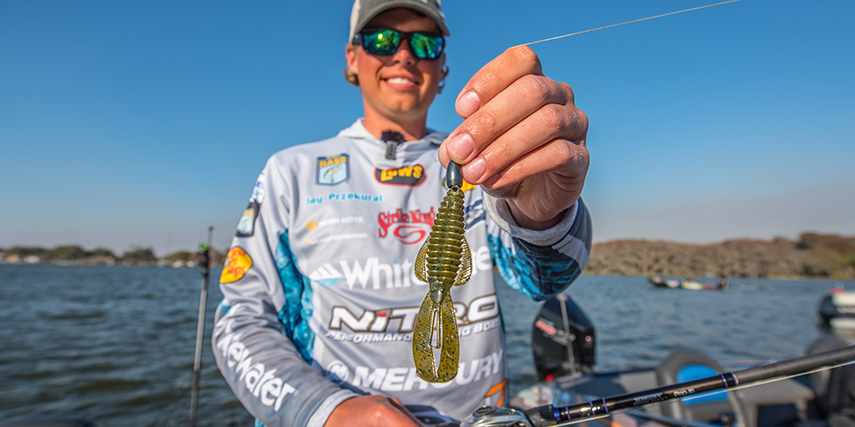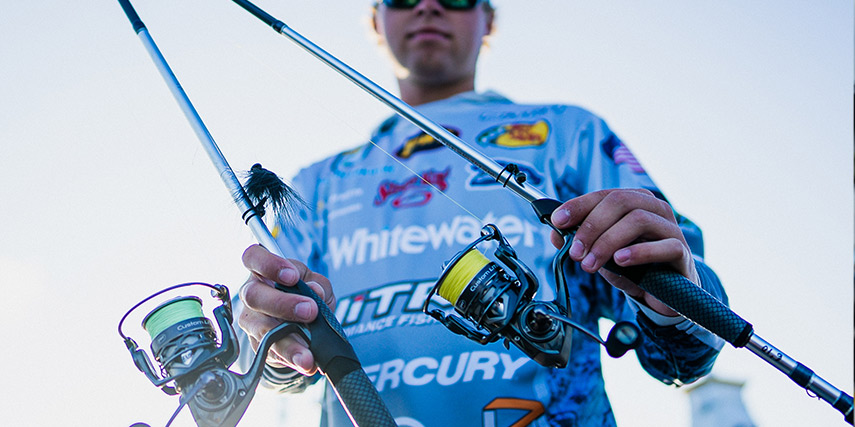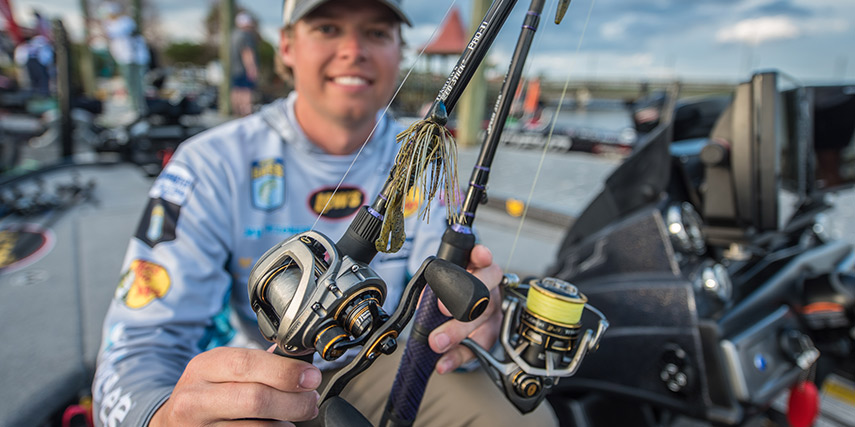
The fishing pro on the VHS tape explained that fishing line can weaken over time and that it was essential to check the line often by running your fingers back and forth on it. The line should feel smooth between your fingers. If any bumps were detected, it was time to change it.
Oh, how times have changed. Only one type of fishing line was mentioned on that VHS tape; nylon monofilament line was all anyone used back then. In today’s world of fishing, however, anglers have multiple types of lines, different colors, and different strengths, all of them having their specific purpose.
Beginning fishermen may not understand the different types of fishing lines or know when and where to use each of them. Today, there are three main types, each having pros and cons. They are monofilament line, fluorocarbon line, and braid or braided line. In this blog, we will break down each type of line, and explain the advantages of using it as well as when each type should be used.

Monofilament
Monofilament is probably the most recognized and used line as it has been around the longest of the three. Monofilament fishing line is made from a single thread of nylon material. One of the most significant benefits of monofilament is that it is perfect for beginning anglers. It is the easiest for anglers to tie a good, tight knot without weakening the line. “Mono” also has excellent tensile strength and flexibility, and it is reasonably cheap to buy when anglers are in the learning stage.
When looking at flexibility, mono is often noted as a line that will stretch. Stretching is good when trying to set the hook on a fish that is swimming away quickly; the line stretches enough, to give time for the angler to set the hook without snapping the line or pulling the hooks from the fish’s mouth. Think of this flexibility as a shock absorber that can protect your rod from breaking, as well as the fish’s delicate mouth.
Even though mono is commonly referred to as a beginner's line, pros alike still have a few rods and reels spooled with a monofilament line. The advantage for more advanced anglers is that mono is more buoyant and is often used for topwater presentations or other applications when there is a need for the lure to sink more slowly.
Monofilament line is available in several colors and in a wide range of sizes between 2-lb.test for ice fishing and panfish applications up to 1,000-lb. test which is used for constructing leaders for extremely large fish like marlin. For most freshwater fishing applications, 2-6-lb. test sizes are popular for panfish, and 6-20-lb. test are popular sizes for bass and other gamefish. Your fishing rod will usually have a printed label that shows what size lines it was designed to work with. Your reel will also tell you how many yards of different sizes of line it can hold. Clear monofilament is the best choice for clear-water environments, and green is a popular tint for murkier or stained water.
It should be noted that mono should not be considered a cheap line; there are cheap and expensive versions of all line types available in almost every sporting goods store.

Fluorocarbon
If you keep up with modern trends in fishing, there is a good chance you have heard of fluorocarbon fishing line. It is probably safe to say that ninety percent of the more advanced anglers use fluorocarbon in certain applications. This type of line is also made of a single strand, except it is somewhat thicker and harder with less stretch and has a non-toxic composition. 100% fluorocarbon also has a refractive index that is very close to that of water, meaning it blends in better and is less visible than any other kind of fishing line.
One of the most significant advantage of fluorocarbon is its toughness. The term most often associated with fluorocarbon is that it is more abrasion resistant than regular mono line. Fluorocarbon stays tough longer because it is physically harder than monofilament and does not break down or become weakened by UV rays. Another advantage it has over mono is that it does not absorb water like mono often does, making fluorocarbon last longer. It also sinks faster than mono. This feature has benefits in many presentations like casting crankbaits, for example. A crankbait casted and retrieved on fluorocarbon line will dive deeper and faster than the same crankbait casted on monofilament line.
Many anglers want an abrasion-resistant fishing line due to the minimal breakage and fewer missed fish when reeling near debris such as rocks or logs. Fluorocarbon also possesses low visibility. Even though fluoro has a slightly larger diameter than mono line of the same rated strength, its material provides very low distinguishability in the water, which can result in more strikes.
Anglers also prefer fluoro because of its sensitivity when feeling a fish bite. This increased sensitivity comes from the fact that it hardly stretches at all, but the lack of elasticity means it is also less forgiving.
Some anglers steer away from fluoro because of its price. Fluorocarbon is a bit higher priced than mono, yet the saying “you get what you pay for” plays true in this case and the pros outweigh the cons for most anglers.

Braid
If you are tired of breaking your line, you might want to try a braided line. Braid is much different from the other two lines. It is made of different types of materials that are woven or fused together to create a super-strong line. Because it is made with multiple super-strong materials, the diameter of braided line is smaller than mono or fluoro lines of the same breaking strength. In other words, 30-or-40-lb. braided line may have the same diameter as 8- or 10-lb. monofilament line. Similarly, 8-lb. braid may have the same approximate diameter as 2-lb. monofilament. Since larger diameter lines don’t cast as far as smaller ones, anglers using braided line can enjoy longer casting without sacrificing strength.
One of the most common areas where anglers use the braided line is around heavy cover such as grass or lily pads. When fishing on top of thick grass or pads with lures such as a frog, anglers require a line that is not going to snag or break when it gets tangled. Braid is also a lower stretching line, which gives the angler an advantage when pulling hard-hitting bass out of heavy cover.
Braid is also commonly used in presentations that require maximum sensitivity, like vertical jigging in deep water or in other bottom-contact situations.
Braided line comes in many colors. Olive green and smoke are less visible to the fish but are still much more visible underwater than either fluorocarbon or monofilament. For this reason, many anglers will tie a section of fluorocarbon leader between the main braided line and the lure to minimize visibility to the fish. When a fluorocarbon leader is used, brighter colors of braided line like hi-vis green, yellow and white are popular choices with anglers fishing finesse presentations like Texas-rigged plastics, wacky-worm rigs and light jigs, because they can often see the line move before they can actually feel that a fish has picked up the lure.
One of the most significant disadvantages to braid is tangling and knots. Braid tends to be more supple than mono or fluoro – especially in the smaller sizes – so it tends to tangle more easily around rod guides. Braid also tends to be the costliest out of the three lines. However, if the higher strength prevents the line from breaking and results in fewer lost lures, the higher cost of braid can be justified by many anglers.





